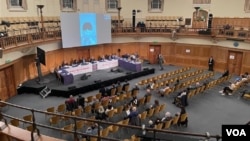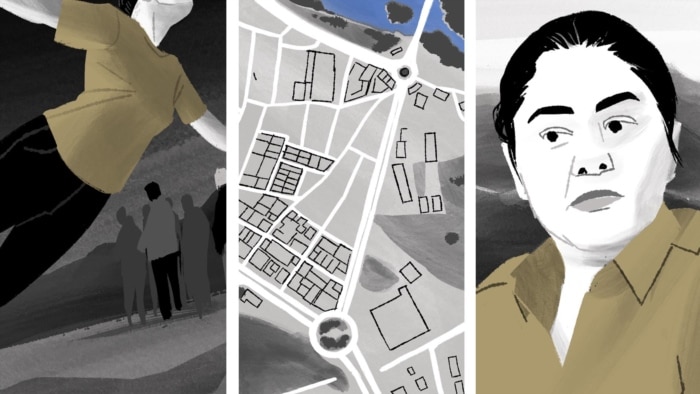Witnesses, human rights lawyers, international prosecutors and academics gathered Thursday in London for the second day of the Iran Atrocities Tribunal to investigate how mostly peaceful protests turned violent two years ago.
Iranian security forces killed hundreds and arrested thousands of people who were demonstrating against a sudden spike in fuel prices in mid-November 2019. The Iranian government raised the subsidized price of gasoline by 50%, angering Iranians facing high unemployment, inflation and heavy U.S. sanctions.
Appearing virtually and in person at a conference hall in Westminster, the witnesses described in detail the deadly crackdown by authorities two years ago. Some spoke live, others via taped testimonies, with many wearing masks and sunglasses to conceal their identities for fear of reprisals by the Iranian government against family members.
Some showed photos of dead children. One woman, grasping a picture of her son with his own children, asked during the opening session Wednesday whom she could turn to without help from Iranian courts.
“I don’t know what to do and where to go,” she said. “In this world, isn’t there anyone who can hear my cries?”
Former police officer testifies
Thursday’s session featured a former Iranian police officer — identified only as “Witness 195” — who recalled intelligence agents “spraying the protesters with bullets.” Another person, “Witness 366,” showed X-rays of bullets lodged near his lungs.
The tribunal is organized by civil society groups Justice for Iran, Iran Human Rights and Ensemble Contre la Peine de Mort (Together Against the Death Penalty) and will hear evidence from more than 160 witnesses over four days but carries no legal standing.
As the tribunal proceeds, Amnesty International called Thursday for the international community to listen carefully.
“The hearings at the International People’s Tribunal on Iran’s Atrocities of November 2019 are crucial for ensuring that these atrocities do not fade into memory,” Heba Morayef, the human rights organization’s regional director for the Middle East and North Africa, said in a statement. “Crucially, the tribunal must spur U.N. member states into action.”
Raha Bahreini, an Amnesty International researcher and human rights lawyer, said during Thursday’s session that many protesters were sexually assaulted, tortured and executed by Iranian forces two years ago.
On its website, the Iran Atrocities Tribunal, also known as the Aban Tribunal, says its panelists will determine whether Iranian security forces violated international law and will identify perpetrators after proceedings wrap up November 14. Their findings will be released in early 2022.
24 more victims
Amnesty International also updated its list of people killed in the crackdown. It added 24 newly identified names to the database, which now lists 323 Iranians killed in protests across the country November 15-19, 2019.
One of these victims was Pejman Gholipour Malati, an 18-year-old shot in Tehran. His mother, Mahboubeh Ramazani, spoke at Wednesday’s tribunal via recorded video, surrounded by decorations to mark her son's 20th birthday.
“We want justice. Hear our cries,” she said. “Tell us who killed our children. … We lost our loved ones in our own homeland.”
Ramazani’s camera panned to a neatly made bed: “My son’s empty bed that I see every day,” she said. Then black pants hanging from a door: “Clothes of Pejman I hanged here, in case he returns one day.” A red box crossed with white ribbon: “My son’s bloody clothes are in that box. They’d removed them in the hospital. There were holes in them.”

